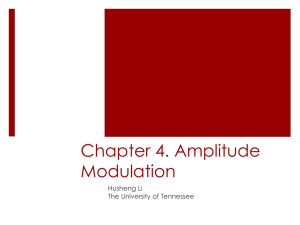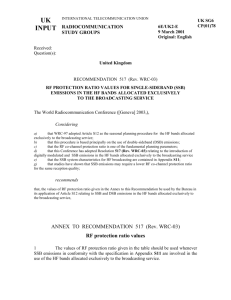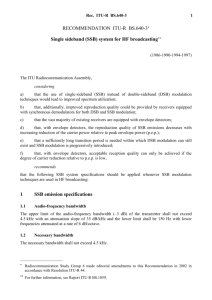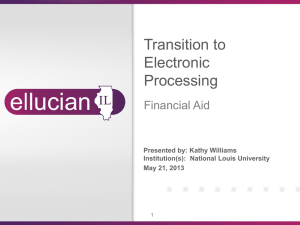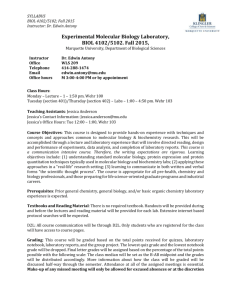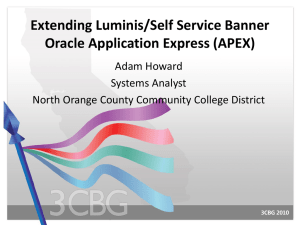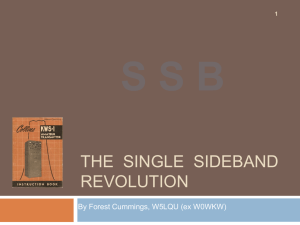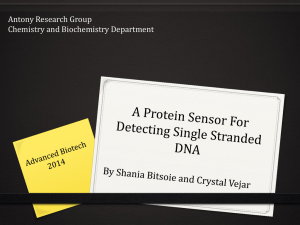REPORT ITU-R M.2026 - Adaptability of real zero single sideband
advertisement
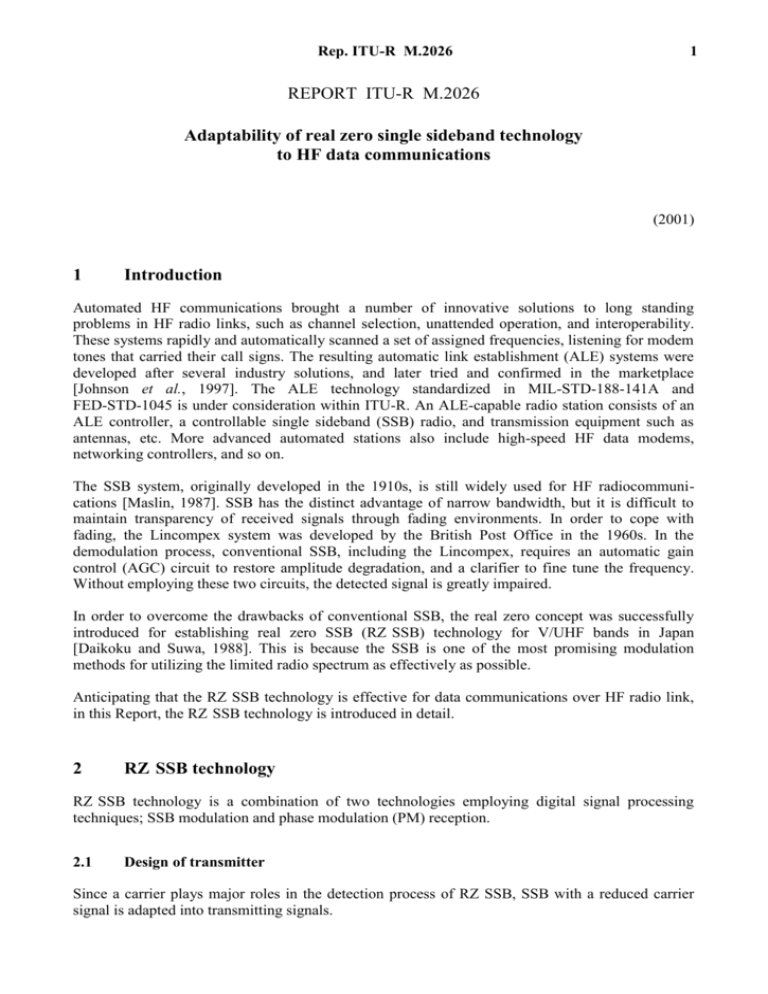
Rep. ITU-R M.2026 1 REPORT ITU-R M.2026 Adaptability of real zero single sideband technology to HF data communications (2001) 1 Introduction Automated HF communications brought a number of innovative solutions to long standing problems in HF radio links, such as channel selection, unattended operation, and interoperability. These systems rapidly and automatically scanned a set of assigned frequencies, listening for modem tones that carried their call signs. The resulting automatic link establishment (ALE) systems were developed after several industry solutions, and later tried and confirmed in the marketplace [Johnson et al., 1997]. The ALE technology standardized in MIL-STD-188-141A and FED-STD-1045 is under consideration within ITU-R. An ALE-capable radio station consists of an ALE controller, a controllable single sideband (SSB) radio, and transmission equipment such as antennas, etc. More advanced automated stations also include high-speed HF data modems, networking controllers, and so on. The SSB system, originally developed in the 1910s, is still widely used for HF radiocommunications [Maslin, 1987]. SSB has the distinct advantage of narrow bandwidth, but it is difficult to maintain transparency of received signals through fading environments. In order to cope with fading, the Lincompex system was developed by the British Post Office in the 1960s. In the demodulation process, conventional SSB, including the Lincompex, requires an automatic gain control (AGC) circuit to restore amplitude degradation, and a clarifier to fine tune the frequency. Without employing these two circuits, the detected signal is greatly impaired. In order to overcome the drawbacks of conventional SSB, the real zero concept was successfully introduced for establishing real zero SSB (RZ SSB) technology for V/UHF bands in Japan [Daikoku and Suwa, 1988]. This is because the SSB is one of the most promising modulation methods for utilizing the limited radio spectrum as effectively as possible. Anticipating that the RZ SSB technology is effective for data communications over HF radio link, in this Report, the RZ SSB technology is introduced in detail. 2 RZ SSB technology RZ SSB technology is a combination of two technologies employing digital signal processing techniques; SSB modulation and phase modulation (PM) reception. 2.1 Design of transmitter Since a carrier plays major roles in the detection process of RZ SSB, SSB with a reduced carrier signal is adapted into transmitting signals. 2 2.1.1 Rep. ITU-R M.2026 Generation of SSB signal For generating SSB signals, there are three methods, the filter method, the phasing (phase-shift) method, and the Weaver method [Sabin and Schoenike, 1987]. Among them, the phasing method is selected. This is because SSB signal can be generated without using a band pass filter (BPF) with sharp attenuation characteristics which induces severe impairment on the information signal. The phasing method however requires a Hilbert transformer for an information signal with reasonable accuracy, which is somewhat difficult to actually fabricate. To avoid this, it is desirable to fabricate a Hilbert large scale integration (LSI) transformer using digital signal processing technology. 2.1.2 Linear power amplifier The simplest means of increasing the received signal strength is to increase the transmitter power. The result may introduce spurious effects at the transmit terminal, and will cause further pollution of the radio spectrum. RF feedback can be effective for reducing both amplitude and phase distortion. However, there are some limitations in conventional RF feedback techniques where some amount of RF output signal expressed as a scalar quantity is merely returned to the input port. Recently, a Cartesian feedback loop technique, in which the amount of feedback is treated in the Cartesian (orthogonal) coordinate just as with a vector quantity, has been successfully developed to fabricate a linear amplifier for narrow-band radio in the V/UHF bands [Nagata, 1989]. As the Hilbert pair inherently is orthogonal to each other [Hahn, 1996], the Cartesian feedback loop technique is easily introduced for fabrication of the linear amplifier for SSB systems. 2.1.3 Information signal bandwidth The information bandwidth for conventional SSB ranges from 350 Hz to 2.7 kHz within a 3.0 kHz channel spacing. In contrast with SSB, the information bandwidth for RZ SSB can be extended up to 3.4 kHz. 2.2 Design of receiver for no degradation from mistuned carrier and immunity from fading Since SSB is susceptible to carrier synchronization and to severe fading encountered in mobile environments, two breakthrough technologies are introduced into the RZ SSB demodulation process to cope with these issues. 2.2.1 New demodulation method The first breakthrough is a new demodulation method that makes use of the zero crossings of the received signals. The conventional SSB receiver employs both an AGC circuit and a clarifier (or a high stability oscillator). As these circuits limit performance of conventional SSB, RZ SSB takes a completely different approach in order to achieve superior transmission quality without employing these performance limiting circuits in a receiver. In 1977, Dr. Benjamin F. Logan of Bell Labs. showed using the entire function theory that the information can be recovered, without any loss, from the zero crossings of band-pass signals such as RZ SSB [Logan, 1977]. This means that it is unnecessary, as it is in the conventional SSB Rep. ITU-R M.2026 3 receiver, to recover information signal from both the envelope and phase of the received SSB signal; an information signal can be recovered independently of the amplitude of the signal, just as in FM. Dr. Logan however, never demonstrated how to recover the information signal from the zero crossings and indicated that in his paper that it would be “difficult and impractical” to do so. The RZ SSB demodulation method provides an easy and practical solution to this problem. The zero crossings are mathematically expressed by real zeros, not by complex zeros; therefore, the technology described here was named RZ SSB in respect for the academic achievements of Dr. Logan. The novel demodulation method of RZ SSB means that the RZ SSB receiver is drastically different from a conventional SSB receiver. The basic RZ SSB receiver consists of a hard amplitude limiter, frequency discriminator, integrator, and linearizer. A received signal, reduced-carrier SSB, is first processed to increase the level of the carrier to create a full-carrier SSB, that is, RZ SSB signal, where the zero crossing information can only be found in the phase component. In order to precisely detect the phase component, the amplitude variation must be removed using a hard amplitude limiter. The phase of the output of this limiter is detected using a frequency discriminator and an integrator. The integrated signal is then processed by a linearizer which exactly reproduces the information signal transmitted. The most essential circuit for an RZ SSB receiver is the linearizer; this complex circuit is reduced in size to an integrated circuit where accurate performance is achieved through the use of latest digital signal processing technology. In the newly developed RZ SSB demodulation process, the carrier component is always converted to the DC component of information signals. Therefore, the RZ SSB receiver is completely free from degradation caused by a mistuned carrier, that is, carrier frequency and/or phase drifts. Such degradation typically arises in the conventional SSB receiver, and thus a clarifier (or a high stability oscillator) is required to reduce this degradation. 2.2.2 Anti-fading technology The second breakthrough is the introduction of anti-fading technology. As the effect of fading is multiplicative, both the amplitude and phase components of received signals are degraded by severe fading. Unfortunately, in conventional SSB, no means has been found to compensate for such degradation. In contrast, in the RZ SSB demodulation process, the degraded amplitude is discarded using the hard amplitude limiter, and a random FM canceller is introduced to remove degradation in the phase component contaminated by fading. A random FM noise canceller that has an output signal phase completely independent of the phase of the input signal coming from an antenna is effective for single branch reception. When two branch diversity reception using an equal-gain combining technique is introduced into the RZ SSB, reception provided is largely immune to fading. However, it is difficult to obtain the sufficient spacing of antennas in the receiving or transmitting array for the HF band. In this case, polarization diversity, rather than space diversity, may minimize antenna configurations and real estate. 4 3 Rep. ITU-R M.2026 Field test of RZ SSB There is a great deal of difference between the propagation characteristics of HF and those of VHF bands. As RZ SSB offers a notable innovation over conventional SSB technology in the VHF bands, there is convincing evidence that the RZ SSB may be useful for overcoming the fundamental and traditional weaknesses in HF communications. For this, field tests, employing four frequencies in 3, 5, 8 and 11 MHz bands, are conducted in order to investigate the adaptability of RZ SSB to HF bands. The actual field trial for the HF band will examine whether RZ SSB is effective for improving transmission quality in fading environments, and whether RZ SSB is able to support data communications within the present technical as well as regulatory conditions. The transmission performance of RZ SSB has been extensively examined through laboratory and field tests using VHF bands. Laboratory experiments have been conducted in order to evaluate RZ SSB performance through the use of mobile radio propagation simulators which can precisely simulate fading environments encountered in mobile radio channels, as well as thermal noise environments. This system allows the transmission and reception testing of a wide range of information signals such as tone, voice, music, modem at various bit rates, G3 facsimile, still picture, etc. In 1992, field tests of RZ SSB were conducted in the Tokyo metropolitan area using the 150 MHz band. And also, in 1995, field demonstrations were conducted in both Washington D.C. and in Denver, Colorado, using channels in the 220 MHz band [Daikoku and Yamada, 1995]. During the demonstrations, excellent photographic image transmission in fading environments using a 9.6 kbit/s G3 facsimile was highly evaluated. The robustness of RZ SSB in severe fading environments of VHF bands, which was demonstrated by laboratory as well as field tests, allows support of a wide range of applications. RZ SSB is the only SSB technology capable of sending and receiving high quality image as well as high sound quality music without any degradation from a mistuned carrier even through severe fading environments. 4 Discussion and conclusion 4.1 Lincompex versus RZ SSB Dependence upon the sky wave for long-distance communications suffers from a number of disadvantages, such as deep fading, long fade duration, and delay distortion due to multipath propagation, ionospheric layer altitude variation, motion between the transmitter and receiver, etc. In order to cope with such HF band fading, the Lincompex system was developed, and was adopted as a standard ITU-R (Recommendation ITU-R F.455 (1998) – Improved transmission system for HF radiotelephone circuits). The basic principle of the signal processing technique used in Lincompex is that variations in the level of the input speech are compressed to a constant amplitude for transmission. They are expanded again upon reception to the original levels under the operation of a separately transmitted control. Modern Lincompex systems based upon recent digital signal processing technology are now becoming possible and are integrated into HF radio links. Rep. ITU-R M.2026 5 As Lincompex was inherently aimed to improve transmission quality of speech signals for MF/HF maritime mobile radio telephone services, it is natural that Lincompex is not capable of supporting modem signals. Lincompex still suffers from degradation caused by such factors as mistuned carrier, Doppler shift, group delay, etc. In contrast to Lincompex, RZ SSB can overcome such degradation to any degree desired which was verified from its transmission performance of VHF bands in laboratory as well as actual field tests. The advent of RZ SSB has brought about a great advancement in conventional SSB technology since its invention. 4.2 Advent of RZ SSB technology RZ SSB technology has been successful in overcoming the severe fading encountered in mobile environments, and in obtaining superior transmission quality. It extends the available information bandwidth up to 3.4 kHz, identical to that of conventional telephone lines, as a result, RZ SSB can support a wide array of voice, music, data, and facsimile signals, and provides high quality mobile communication with a seamless interface to the telephone network. RZ SSB, in which transmitted information signals are extracted from zero-crossings of received signal, brings with it the following two major features. First, this demodulation method is inherently free from degradation due to a mistuned carrier, which is one of the major drawbacks of conventional SSB. Second, the RZ SSB robustness for fading can be obtained even for single branch reception by introducing a random FM noise canceller into the receiver. It should be added that two-branch space diversity with equal-gain combining is effective to dramatically improve transmission quality for various information signals. Without the introduction into the RZ SSB of these two breakthrough technologies, it would not be possible to provide superior transmission quality for such a wide range of information signals. 4.3 Spectrum efficiency 4.3.1 Frequency spectrum utilization As a worldwide communications medium, HF is subject to the Radio Regulations which have been developed by the ITU. Up until now, a great deal of effort has been made to improve HF radio link quality by employing software as well as hardware innovations. Introduction of a linear amplifier with a Cartesian feedback loop into HF communications may bring forth innovations in existing spectrum efficiencies. A power amplifier with the Cartesian feedback loop allows for suppression of out-of-band radiation in the adjacent channel and spurious levels to as low a level as possible, and results in the forming of a compact modulation spectrum. This means that it is unnecessary to take up bandwidth with emissions outside the channel, and thus it becomes possible to allocate a carrier frequency close to others. 4.3.2 Data communications As data communications in the HF band started being supported by using the conventional SSB system, which may have lacked sufficient robustness to provide high throughput, more effective methods were extensively studied to improve the performance of modems operating in fading 6 Rep. ITU-R M.2026 environments. A variety of modem waveforms were developed over the years to meet HF channel conditions, such as FSK modems, parallel-tone modems, single-tone modems, and so on. Such modem equipment can be appropriately applied to RZ SSB, and therefore, when applying RZ SSB to HF data communications, the same robustness which came from the introduction of the two breakthrough technologies to RZ SSB may also allow an increase in throughput for HF data transmission. References JOHNSON, E. E. et al. [1997] Advanced high-frequency radio communications. Artech House, Boston, United States of America. MASLIN, N. [1987] HF communications: A system approach. Plenum Press New York, United States of America. DAIKOKU, K. and SUWA, K. [November, 1988] RZ SSB transceiver with equal-gain combiner for speech and data transmission. IEEE Globecom ’88, p. 26, § 4.1-§ 4.5. SABIN, W. E. and SCHOENIKE, E. O. [1987] Single-sideband systems and circuits. McGraw-Hill Book Company, New York, United States of America. NAGATA, Y. [May, 1989] Linear amplification technique for digital mobile communications. Proc. 39th IEEE Veh. Tech. Conf., p. 159-164. HAHN, S. L. [1996] Hilbert transforms in signal processing. Artech House, Boston, United States of America. LOGAN, B. F. [April, 1977] Information in the zero crossings of bandpass signals. Bell Syst. Tech. J., Vol. 56, 4, p. 487-510. DAIKOKU, K. and YAMADA, K. [August, 1995] RZ SSB Very narrow-band technology for the information age, Radio Resources Magazine, p. 42-46.
